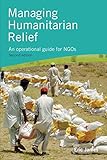Managing humanitarian relief : an operational guide for NGOs / Eric James.
Material type: TextPublisher: Warwickshire : Practical Action Publishing, 2017Edition: Second editionDescription: xxx, 436 pages ; 24 cmContent type:
TextPublisher: Warwickshire : Practical Action Publishing, 2017Edition: Second editionDescription: xxx, 436 pages ; 24 cmContent type: - text
- unmediated
- volume
- 1853399035 (Paperback)
- 9781853399039 (Paperback)
- 363.34/8068 23
- HV553 .J36 2017
| Item type | Current library | Collection | Call number | Copy number | Status | Barcode | |
|---|---|---|---|---|---|---|---|
 Books
Books
|
Rabdan Academy General Stacks | Non-fiction | HV553 .J36 2017 (Browse shelf(Opens below)) | 1 | Available | 158743 |
Includes bibliographical references (pages 409-412) and index.
Understanding emergencies and disaster-affected populations -- Understanding disaster-affected populations and programme sectors -- Managing in emergencies -- Carrying out an assessment -- Launching in a new country or area -- Establishing an office and acommodation -- Preparing a proposal and negotiating with donors -- Managing human resources -- Planning, managing and reporting on a project -- Dealing with stress -- Overseeing finance and accounting -- Setting up a logistics and procurement system -- Handling transport and maintaining vehicles -- Communication using radios and satellites -- Working with local partners and contractors -- Building internal capacity -- Dealing with the media -- Managing security -- Monitoring and evaluating a project -- Coordinating with other organizations -- Closing an emergency programme.
"Armed conflicts, natural disasters and environmental degradation result in human misery, and the common response is to want to help. Responding effectively to humanitarian disasters is far from straightforward, however, and relief workers often find themselves in a world of uncoordinated, highly competitive agencies where teh 'why' and 'how' to provide relief is far from clear. Managing Humanitarian Relief is aimed at the relief worker who in the midst of these complex situations is putting together programmes of action to help people in extreme crisis. It provides humanitarian relief managers with a single comprehensive reference for many of the management issues they are likely to encounter in the field. Designed for the generalist and for those in management positions, the book provides enough background for readers to understand the topics quickly and to put them into practice in the field. Its easy-to-use format includes essential information checklists, tables, diagrams, sample forms, and no-nonsense tips from practitioners to help readers in emergency situations. The second edition brings the reader up to date with recent humanitarian reforms; the use of GIS and mobile technologies; funding innovations; economic recovery, cash and vouchers, and microfinance; tents and other temporary constructions and building materials." --back cover.
There are no comments on this title.
